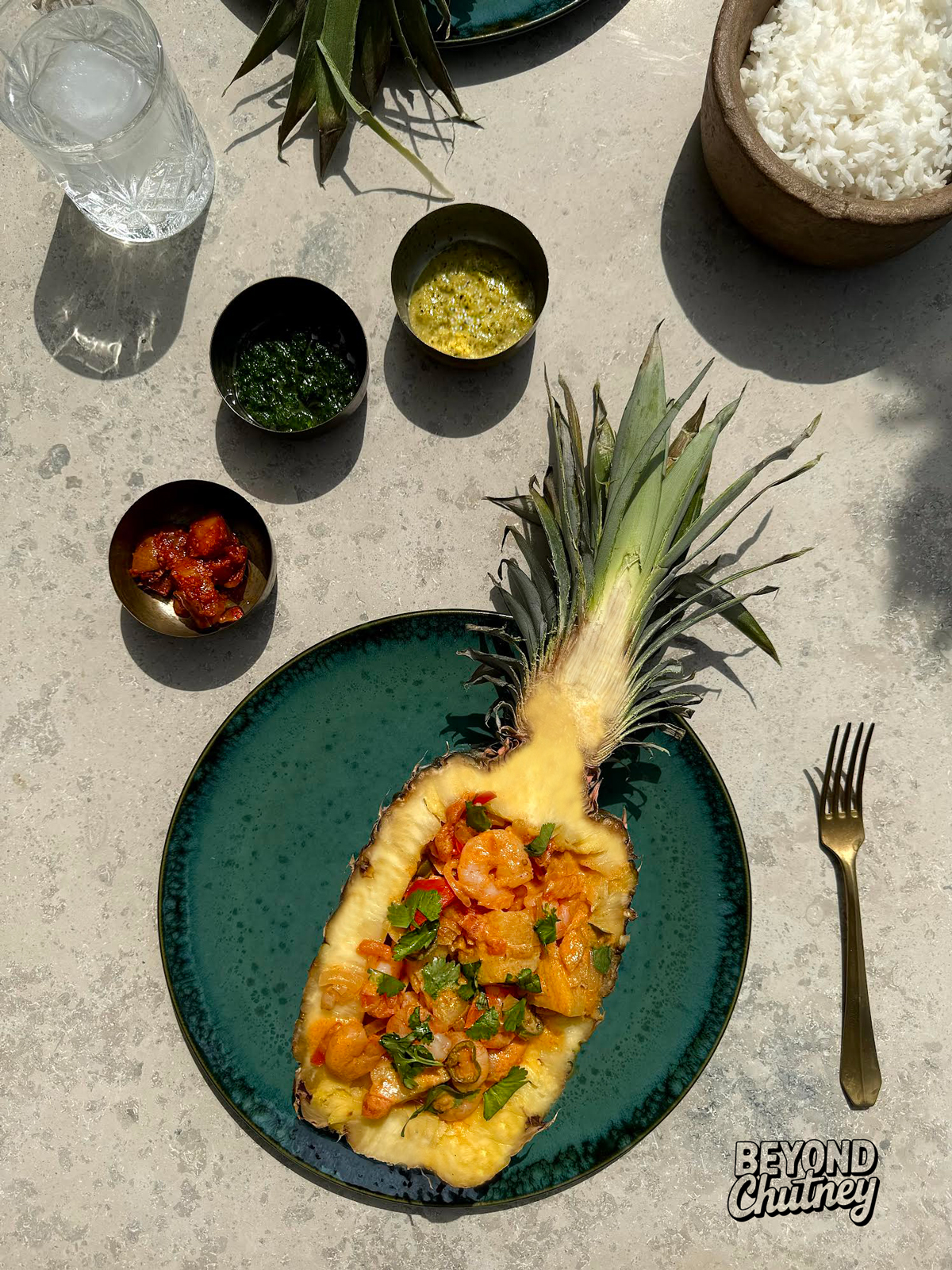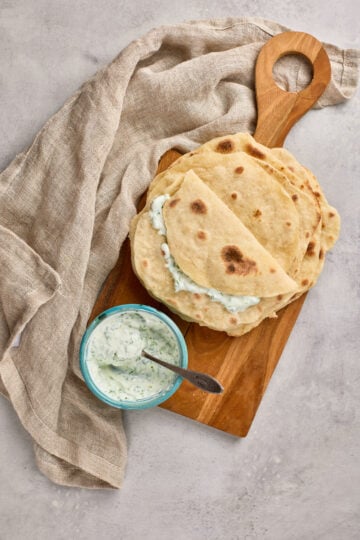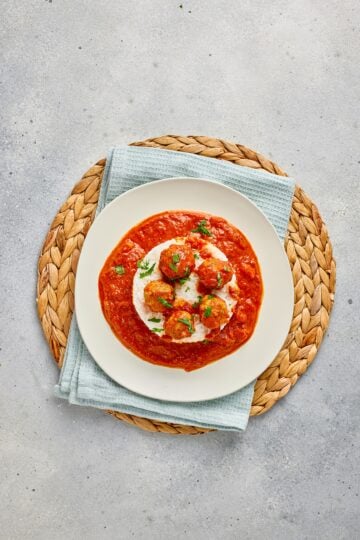
Pineapple in a curry might sound unexpected at first — but it works beautifully. Indian curries are known for their bold, layered flavors, and this one is no exception. Ana Chingri, a prawn and pineapple curry from eastern India, is a perfect example of how contrasting ingredients can come together in harmony.
The dish is believed to have originated in Kolkata during the colonial period, when prawns were a delicacy and tropical fruits like pineapple were prized ingredients. The British reportedly developed a fondness for it and speculated that it might have been influenced by Malaysian Maloy curries. Over time, Ana Chingri became a celebratory dish across Bengal, often cooked for special occasions.
Like many Indian recipes, it carries cultural meaning beyond taste. In India, ceremonies and guests are welcomed with abundant food and warmth — and Ana Chingri often plays a part in those moments. It’s even a popular choice for Pehli Rasoi, the tradition where a newlywed bride prepares her first meal for her new family, typically featuring a curry and a sweet dish.
In earlier times, prawns were not everyday fare but a sign of festivity and generosity. When Ana Chingri appeared on the table, it meant something joyful was being celebrated. For many who grew up in the ’90s, its sweet-spicy aroma still recalls weddings and family gatherings, carrying the memory of celebration and togetherness.
The pairing of prawns and pineapple might sound unusual, but the result is surprisingly balanced — sweet, spicy, tangy, and savory, with a touch of roasted garlic in every bite. Served with rice and a simple chutney, it’s a dish that leaves a lasting impression and a touch of nostalgia.
If you’ve never tried Ana Chingri before, this is your invitation to bring a bit of Bengali festivity into your kitchen.

Prawn & Pineapple Curry (Ana Chingri)
Ingredients
- 1 ripe pineapple halved lengthwise( Scoop out the fruit, chop it up, and save the shell for serving)
- 500 g raw shrimp, peeled and deveined
- 1 medium onion finely chopped
- 2 green chilies sliced (adjust to taste)
- 1 clove garlic finely chopped
- 1 teaspoon fresh ginger grated
- 1 small tomato finely chopped
- 1 teaspoon tomato paste
- 1 dried bay leaf or tej patta, if you have it
- 1 teaspoon mustard seeds
- ½ teaspoon turmeric
- 1 teaspoon ground coriander
- 1 teaspoon ground cumin
- ½ teaspoon chili powder
- 2 tablespoon coconut oil
- 100 ml water
- 100 ml coconut milk optional, but really nice
- Salt to taste
- A squeeze of lime juice or
- Fresh cilantro for serving
Instructions
- Slice the pineapple in half lengthwise. Use a knife and spoon to gently scoop out the fruit, leaving about 1 cm around the edges. Chop the flesh into small pieces and set aside. Keep the pineapple shells—you’ll serve the curry in them later.
- Toss the shrimp with a little salt and half the turmeric (about ¼ tsp). Let it sit while you start the curry.
- Heat coconut oil in a large pan. Add the mustard seeds and let them pop. Then toss in the bay leaf, onion, green chilies, garlic, and ginger. Cook on medium heat until everything softens and smells amazing.
- Stir in the tomato and tomato paste. Let it cook down for 2–3 minutes. Then add cumin, coriander, chili powder (if using), and the rest of the turmeric. Cook for another minute or two until it forms a nice, thick base.
- Add pineapple & shrimp:
- Add the chopped pineapple and shrimp to the pan. Stir well to coat everything in the spice mix.
- Pour in 100 ml water and, if you’re using it, 100 ml coconut milk. Add salt, bring it to a simmer, and let it cook for about 5–7 minutes—just until the shrimp are cooked through and the sauce thickens a bit.
- Squeeze in some lime juice (or stir in a little tamarind paste) to balance the sweetness. Taste and adjust salt or chili if needed.
- Spoon the curry into the hollowed-out pineapple halves. Sprinkle with fresh cilantro and serve hot with steamed basmati rice.
Notes
🍍 Practical & Helpful:
- Choose the right pineapple: Go for a pineapple that's golden and smells sweet at the base. If it's underripe, the curry will lack that juicy punch.
- Don't throw away the pineapple juice: When scooping the pineapple, collect the juice—it’s liquid gold! You can add a spoonful to the curry for extra sweetness or sip it while cooking like a tropical chef.
- Shrimp cook fast: Overcooked shrimp = rubbery disaster. As soon as they curl up and turn pink, you're done.
- Not a fan of coconut milk? Skip it. But if you use it, the curry becomes richer and smoother—especially great if your pineapple is very tangy.
- Spice it your way: Want it milder? Remove chili seeds or use just one chili. Want it fierier? Add a pinch of red chili flakes at the end.
- No tamarind? No problem. Lime juice works great. Or use a splash of vinegar with a pinch of sugar as a backup.
- Make it ahead: The curry tastes even better the next day, after the flavors mingle. Just store the pineapple bowls and curry separately.
- Serving tip: Serving in pineapple halves is optional but it adds a fun, tropical touch that makes the dish feel extra special.
- Rice pairing: Plain steamed basmati works best. Coconut rice or jeera rice also go great if you're feeling fancy.
- Vegetarian twist: Swap shrimp for paneer, tofu, or chickpeas and follow the same recipe for a tropical veggie delight.
Recipe Twist Ideas
1. Coconut Milk Version
Swap part or all of the water with coconut milk for a richer, creamier curry with a gentle sweetness that pairs well with pineapple.2. Add Vegetables
Stir in bell peppers, okra, or baby spinach during the last few minutes of cooking for extra color and nutrition.3. Tamarind Tang
Add a small spoon of tamarind pulp instead of tomatoes or along with them for deeper tang and a South Indian-style variation.4. Bengali Panch Phoron Twist
Start the tempering with panch phoron (Bengali five-spice mix) instead of just mustard seeds for a more regional, aromatic base.5. Grilled Pineapple
Char or grill some pineapple slices before adding them to the curry for a smoky-sweet depth.6. No-Prawn Veggie Version
Swap prawns with paneer, tofu, or mushrooms to make a vegetarian-friendly version with similar flavors.7. Dry Style
Reduce the liquid and cook it down further to create a semi-dry curry, perfect for scooping with flatbreads like paratha or naan.8. Add Cashew Paste
Blend a few soaked cashews into the gravy for a creamier texture and mild nutty taste—works especially well for festive meals.9. Spicy Version
Add green chilies or a spoon of red chili paste to bump up the heat for spice lovers.10. Mango Variation
Substitute part of the pineapple with ripe mango chunks (or a splash of mango purée) for a tropical, sweet-tangy fusion.Nutrition
FAQ
Where does Ana Chingri come from?
Ana Chingri is a traditional Bengali dish that likely originated in Kolkata. It became popular during the colonial period, when prawns were considered a luxury and pineapple was a prized tropical fruit. Over time, it became a festive curry often served at celebrations and family gatherings.
Why does this curry include pineapple?
Pineapple adds a natural sweetness that balances the heat of chilies and spices. In eastern Indian cuisine, fruits like pineapple or green mango are sometimes added to curries for a tangy-sweet note, especially in festive dishes.
Can I use canned pineapple instead of fresh?
Fresh pineapple gives the best flavor, but canned pineapple works too. Just choose one packed in juice, not syrup, and reduce the sweetness elsewhere in the recipe.
What’s the best way to prepare prawns for this curry?
Use fresh or thawed raw prawns, peeled and deveined. Marinate them briefly with salt and turmeric before cooking — this helps firm the texture and enhances the color. Avoid overcooking, as prawns turn rubbery quickly.
Is coconut milk essential?
No. The dish tastes great without it, but adding coconut milk creates a creamier texture and mellows the tanginess of the pineapple. It’s optional but recommended.
What does Ana Chingri taste like?
It’s a mix of sweet, tangy, spicy, and savory flavors. The pineapple brings a tropical sweetness, while mustard seeds, chilies, and ginger give it depth. The balance of flavors is what makes this curry memorable.
What should I serve it with?
Plain steamed basmati rice is traditional, but it also pairs well with coconut rice or jeera rice. For something different, try it with soft naan or paratha.
Can I make it ahead?
Yes. The flavors deepen overnight, so the curry often tastes even better the next day. Store it in an airtight container in the fridge for up to two days and reheat gently before serving.
How long can I keep it in the fridge?
Up to 2–3 days. Keep the curry and pineapple shells separate if you plan to reuse them for serving.
Can I freeze this curry?
You can, but the texture of the pineapple may soften a little after thawing. Freeze only the curry (not the pineapple shells) for up to two months, and thaw it in the fridge overnight.
Can I make a vegetarian version?
Absolutely. Swap prawns for paneer, tofu, or chickpeas. The sweet-spicy sauce pairs beautifully with all three.
How spicy is Ana Chingri?
The dish is medium spicy by default. You can control the heat by adjusting the number of green chilies or removing their seeds.
What type of oil works best?
Coconut oil gives the dish a gentle coastal flavor, but mustard oil or sunflower oil can also be used.
Why serve the curry in pineapple halves?
Serving it in hollowed pineapple shells is traditional in some households and adds a festive touch. It’s completely optional but makes the presentation special.
Can I use frozen prawns?
Yes. Thaw them completely, pat them dry, and follow the same steps. Frozen prawns are a convenient option without much flavor loss.
Is this dish commonly made for special occasions?
Yes. Ana Chingri is often cooked for weddings, celebrations, and festivals in Bengal. It’s also considered a good choice for Pehli Rasoi — the first meal a bride cooks for her new family.
Does this curry have any regional variations?
Yes. Some versions use panch phoron (Bengali five-spice mix) instead of mustard seeds, while others include tamarind or coconut milk for a South Indian-style twist.
Can I make it without garlic and onion?
You can, though it will taste lighter. Add a pinch more ginger and coconut milk for balance if you skip them.
What’s the meaning of “Ana Chingri”?
In Bengali, “Ana” refers to pineapple and “Chingri” means prawn. Together, it literally translates to “Pineapple Prawn Curry.”







Have a question or something to share? Leave a comment below!